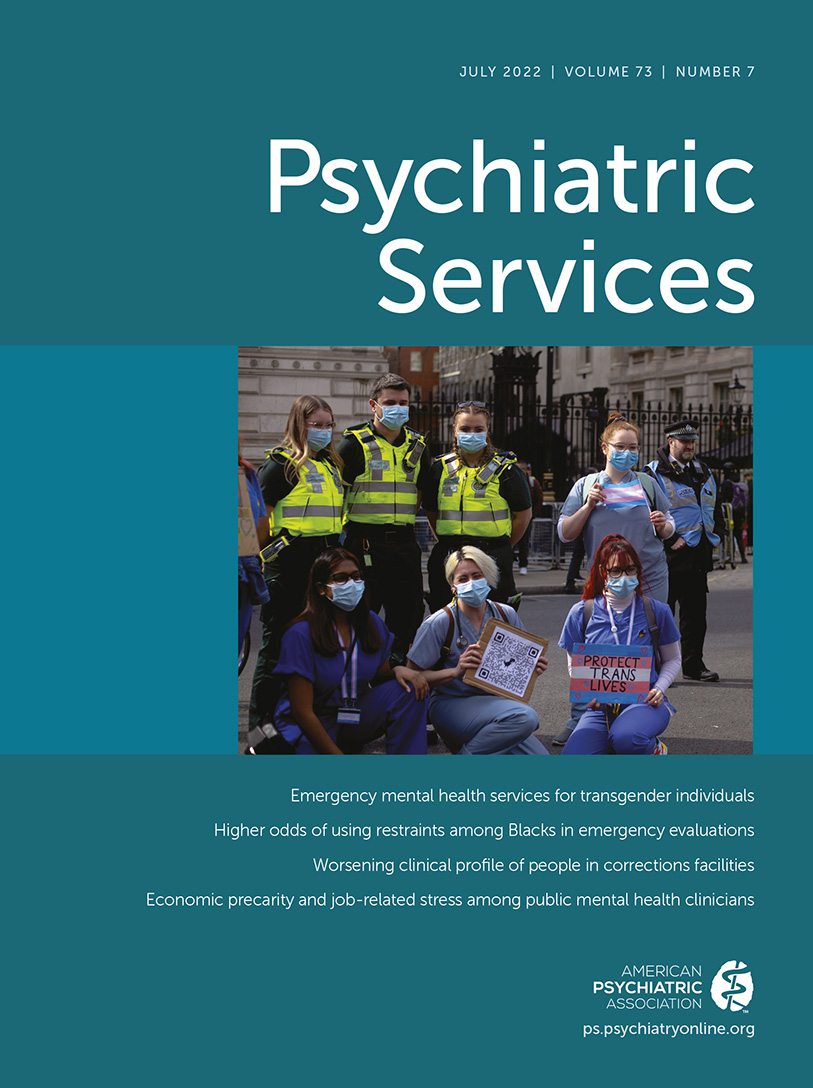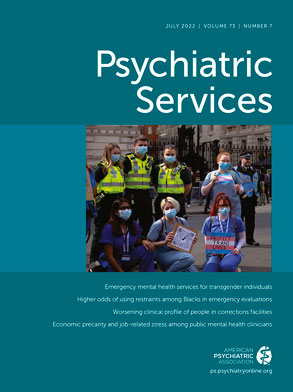Extant research examining trends in mental health service utilization in the United States has found that Latinx residents underuse mental health services compared with non-Latinx Whites. Specifically, among Latinx adults with mental illness, not even 10% have contact with specialty care, and <20% have contact with a general health care provider. Underutilization is even worse among Latinx adolescents with mental illness, with >80% not receiving any care at all. These disparities persist after accounting for symptom severity and insurance and economic factors, pointing to mental illness stigma (hereafter “stigma”) as a key barrier to care.
The studies that examined stigma found that it is higher among Latinx than among non-Latinx White populations (
1). Recent evidence indicates that any exposure to Spanish-language media versus media only in the English language is associated with greater stigma among Latinx youths, suggesting Latinx and Spanish-language media may be an important source of stigma in Latinx communities (
2). Nevertheless, research examining how Latinx and Spanish-language media portray mental illness, compared with how it is portrayed in English-language media, is virtually absent. Also unknown is whether mental health resources such as antistigma media campaigns and mental health prevention hotlines are equitably available across Latinx and Spanish-language media and English-language media. Together, this paucity of research has likely masked disparities across media languages in mental health–related content that propagates stigma in Latinx communities.
Mass Media and Mental Health: The Case for Examining Latinx and Spanish-Language Media
Mass media play an important role in shaping stigma, particularly among youths. A systematic literature review of 12 unique studies (
3) showed that stigmatizing portrayal of mental illness in the media propagates stigma in the community. Yet, this body of research is limited to English-language media only, overlooking heterogeneity in media exposure among immigrant populations and the impact of Latinx and Spanish-language media on Latinx populations in particular. Another meta-review assessing the efficacy of media-based antistigma interventions among media professionals also found scant attention to Latinx and Spanish-language media in the United States and globally (
4). Across the 27 studies included in the review, none came from the 20 countries where Spanish is the official language, and no U.S. study has assessed Latinx and Spanish-language media or consumers, despite their population size and sociopolitical and cultural influence in the United States.
A recent systematic literature review examining prevalent stigma and stigma-reduction interventions for racial-ethnic minority groups in the United States found just two Latinx-specific interventions in the literature (
1). Both Latinx-specific interventions were tested only among adults and used only printed materials, which are less efficacious than education- or contact-based interventions for reducing stigma (
5). None of the racial-ethnic minority group–specific stigma-reduction interventions in the review engaged minority group–specific media, nor did the review include media as a structural driver of stigma propagation or as a potential medium for culturally tailored stigma-reduction intervention (
1). Thus, generalizability of existing research to Latinx and Spanish-language media is lacking, because this research area has been grossly overlooked. Neglecting Latinx and Spanish-language media in stigma research limits our understanding of how stigma propagates in Latinx communities and restricts our knowledge of best practices for destigmatizing mental illnesses and promoting help-seeking attitudes and behaviors in the Latinx community.
In response to mass gun violence, media attention on mental illness has surged. Although these portrayals have been shown to significantly increase stigma in the population, they have been shown to also shape views about firearms policy in the United States (
6). Yet again, the literature has excluded Latinx and Spanish-language media. How Latinx and Spanish-language media feed into stigmatizing narratives about mental illness after mass shootings remains unknown. How views about firearms policy are consequently affected among Latinx—an influential voting bloc—is also unknown. Considering that homicide, suicide, and accidents are all top-three leading causes of death in 2017 among Latinx males ages 1–44 years and top-five among Latinx females ages 1–44, but not for non-Latinx Whites, inclusion of Latinx and Spanish-language media in population-specific mental health research is urgently needed. Future mental health research at the intersection of mental illness stigma, mass shootings, media, and firearms policy must include Latinx and Spanish-language media samples to eliminate this inequity at the research level and grow this area.
Only three studies have assessed mental illness–related content in Spanish-language newspapers, with only one study (
7) drawing on a comparison with English-language newspapers. Using the largest Spanish-language and English-language newspapers in California, the researchers found that negative portrayals of people with mental illness occurred 70% of the time in Spanish-language stories versus 37% in English-language stories. Just 1% of stories in Spanish provided help-seeking resources versus 55% in English (
7). Two studies, from Spain and the United States, also found high stigmatization in the Spanish press (
8,
9). However, newspapers from Spain are culturally and ethnically different from Spanish-language newspapers in the United States that target diverse Latinx populations from Mexico, Central and South America, and the Caribbean. Furthermore, in the era of digital and social media, young Latinxs rarely read newspapers. Still, these studies suggest differences in the portrayal of mental illness across Latinx and Spanish- and English-language media. Young consumers of Latinx and Spanish-language media may experience reinforced stigma and have fewer help-seeking resources. In contrast, youths who use English-language media may encounter less pejorative content and more help-seeking resources.
If these patterns are consistent in the United States and in other types of media, disadvantages in stigma among consumers of Latinx and Spanish-language versus English-language media can be expected. These patterns may persist because of the lack of scrutiny and historical exclusion of Latinx and Spanish-language media in research. Younger Latinx populations may be particularly affected because of greater vulnerability to the influence of media messaging among youths. Stronger attachment to Latinx identity also does not reduce the influence of Latinx and Spanish-language media on stigma (
2). Rather, youths exposed to Latinx and Spanish-language media with weaker Latinx cultural ties or Spanish-language competencies may not be able to discern the context surrounding stigmatizing content in Latinx and Spanish-language media compared with those with stronger Latinx cultural orientations and Spanish-language skills. Thus, Latinx populations in a bicultural or “in between” context are perhaps most vulnerable to stigma in Spanish-language media, reflecting most of United States–based Latinx populations.
Furthermore, knowledge of media consumption and health communication behaviors among Latinx populations remains unknown. Literature is again scarce and has focused on older adults and recent immigrants only (
10). Understanding media consumption patterns among diverse Latinx groups, particularly those who are young and born in the United States, is essential for identifying relevant media channels and types in studies of mental health–related content and interventions in Latinx and Spanish-language media. As Latinx youths play a critical role as “information leaders” in their families and communities (e.g., in language brokering and knowledge transferring), health communication research, particularly of young Latinx populations, can point to effective stigma prevention and help-seeking promotion strategies in the Latinx community.
Compounding inequities, Latinxs are severely underrepresented in antistigma research. In a meta-analysis of 79 antistigma intervention efficacy studies that included 38,364 participants, only 6% were Latinx versus 61% non-Latinx White, and <1% were children (
5). Language preferences of participants and language availability of the interventions were not reported. Collectively, the results of these studies indicate poor representation of Latinx individuals in stigma prevention research and uncertain reach of antistigma efforts to diverse Latinx populations. Because stigma hampers mental health service use, these omissions by race, ethnicity, language, and age in antistigma research perpetuate mental health inequities and restrict the promotion of help seeking in Latinx communities. Appropriate use of mental health care can have long-lasting positive outcomes. Failure to include Latinx populations in research limits our understanding of how antistigma efforts can close treatment gaps for medically underserved Latinx groups.
The Power of Latinx and Spanish-Language Media for Public Mental Health
The Latinx and Spanish-language media industry has great potential to serve as a vehicle for public mental health intervention, particularly for Latinx populations, and for the narrowing of mental health treatment gaps. Latinx and Spanish-language media will likely be a major influencer of health care in the future, given that Spanish is a leading “power” language worldwide, along with Mandarin and English. In the United States, with >37 million speakers, Spanish is the second-most-spoken language after English. Moreover, Spanish-language television networks in the United States (Univision and Telemundo) have set record-high ratings in 2019, beating out major English networks. Latinx youths (ages 8–18 years) consume on average 4 more hours of media (TV, music, or video games) per day than their non-Latinx White peers. Latinx populations are also young, diverse, and on track to becoming the largest racial-ethnic group in the United States.
Moreover, Latinxs are not the only consumers of Latinx and Spanish-language media. In 2020, four of the most popular urban Latinx artists headlined a bilingual, historic Super Bowl halftime show that drew 104 million viewers. These trends necessitate the development of insights into how Latinx and Spanish-language media may propagate stigma of mental health and how they instead could prevent stigma and promote help seeking. To increase the conduct of research on the role of Latinx and Spanish-language media in propagating and preventing stigma, public and private funders must encourage opportunities to pursue this research agenda and provide the necessary financial and human capital to do so. Funding for health communication research programs that prioritize Latinx and Spanish-language media is critical to growing the evidence base in this research area.
Toward Mental Health Equity: Future Directions for Inclusivity of Latinx and Spanish-Language Media
Attentiveness to the gaps in mental health research regarding Latinx and Spanish-language media is critical to addressing low mental health service use among Latinx populations and to attaining mental health equity. Future research must generate knowledge about mental health–related content in Latinx and Spanish-language media that is currently extremely limited for older adult Latinx consumers and virtually nonexistent for young consumers. Findings in this research area may foster the adoption of Latinx and Spanish-language media as a potential tool for intervention. Latinx and Spanish-language media professionals may also be interested in delivering mental health–focused media campaigns in their industry. Generating new knowledge in this area is necessary to innovate partnerships between public health and media professionals and to develop antistigma strategies that leverage Latinx and Spanish-language media. Finally, future research in this area will facilitate increased awareness of prevalent stigma in Latinx and Spanish-language media and readiness for change among Latinx lay and lived experience communities.
Future research should also comprise interdisciplinary and diverse teams of professionals and peers. To be successful, mental health initiatives that leverage Latinx and Spanish-language media must be guided by rich theory in stigma, mental health help seeking, and health communication, among other frameworks, as well as by multiple disciplines such as medical sociology, communication studies, ethnic and gender studies, and public health. Inclusion of Latinx voices, culture, and linguistic preferences and of those with lived experience with mental illness in study design, research participation, and dissemination plans is essential to maximize external validity of this research to diverse Latinx communities. A comprehensive set of dissemination plans to various key audiences (e.g., scientific, Latinx communities, Latinxs with lived experience with mental illness, and media professionals) will be necessary for successful knowledge translation to these audiences.

